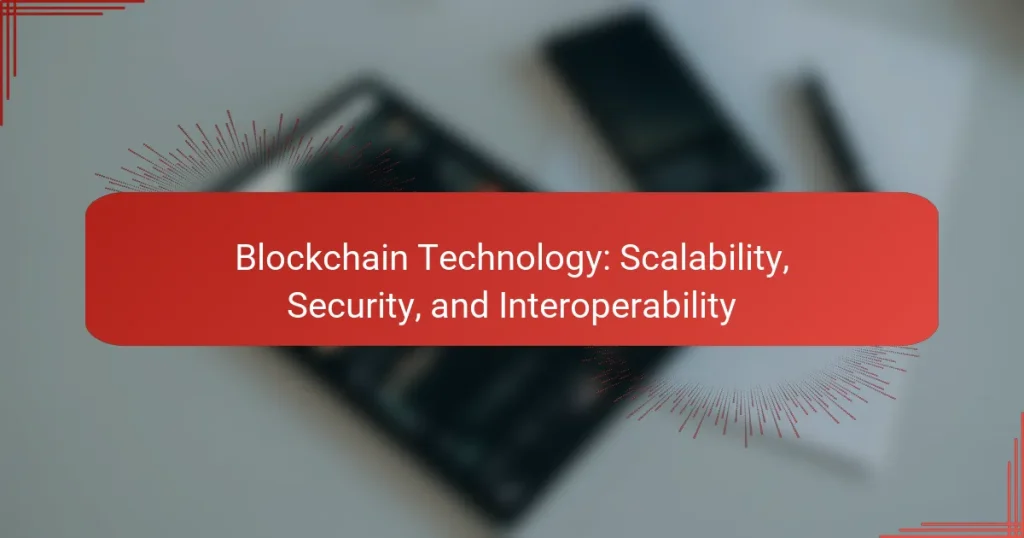Blockchain technology is revolutionizing the digital landscape by addressing critical challenges such as scalability, security, and interoperability. By implementing innovative solutions, it enhances transaction throughput while ensuring robust security through cryptographic measures and consensus protocols. Additionally, interoperability allows diverse blockchain networks to communicate effectively, unlocking new possibilities for decentralized applications and collaborative ecosystems.
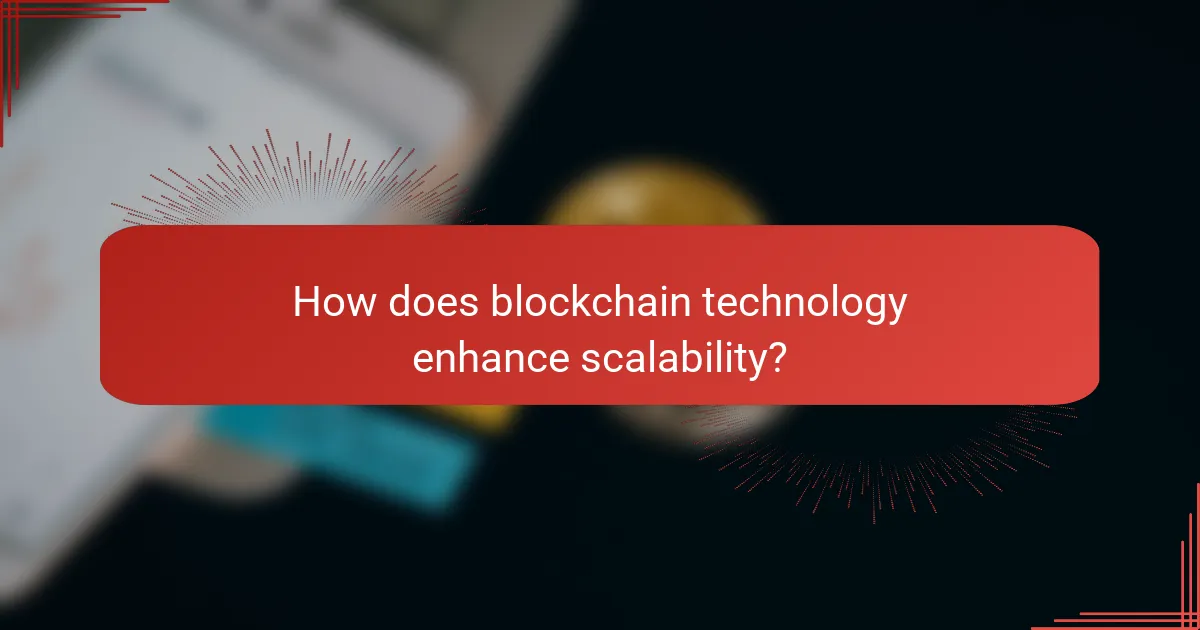
How does blockchain technology enhance scalability?
Blockchain technology enhances scalability by implementing various methods that allow networks to process more transactions simultaneously. These solutions aim to increase throughput and reduce latency, enabling blockchain systems to handle a growing number of users and transactions efficiently.
Layer 2 solutions like Lightning Network
Layer 2 solutions, such as the Lightning Network, operate on top of existing blockchain networks to facilitate faster transactions. By creating off-chain channels, users can conduct multiple transactions without congesting the main blockchain, significantly reducing fees and wait times.
For example, in Bitcoin, the Lightning Network allows users to make instant payments for small transactions, which can be settled later on the main chain. This approach can increase transaction capacity by orders of magnitude, making it suitable for everyday use.
Sharding techniques in Ethereum 2.0
Sharding is a method used in Ethereum 2.0 to improve scalability by dividing the network into smaller, manageable pieces called shards. Each shard processes its transactions and smart contracts independently, allowing the network to handle many transactions in parallel.
This technique can potentially increase Ethereum’s transaction throughput significantly, enabling it to support a larger number of decentralized applications (dApps) and users. However, implementing sharding requires careful design to maintain security and data integrity across shards.
Sidechains for transaction offloading
Sidechains are separate blockchains that run parallel to the main blockchain, allowing for the offloading of transactions. They can be designed to handle specific types of transactions or applications, thereby reducing the load on the main chain.
For instance, a sidechain could be used for high-frequency trading or gaming applications, where speed is crucial. This separation allows the main blockchain to maintain its integrity and security while still providing the necessary scalability for various use cases.
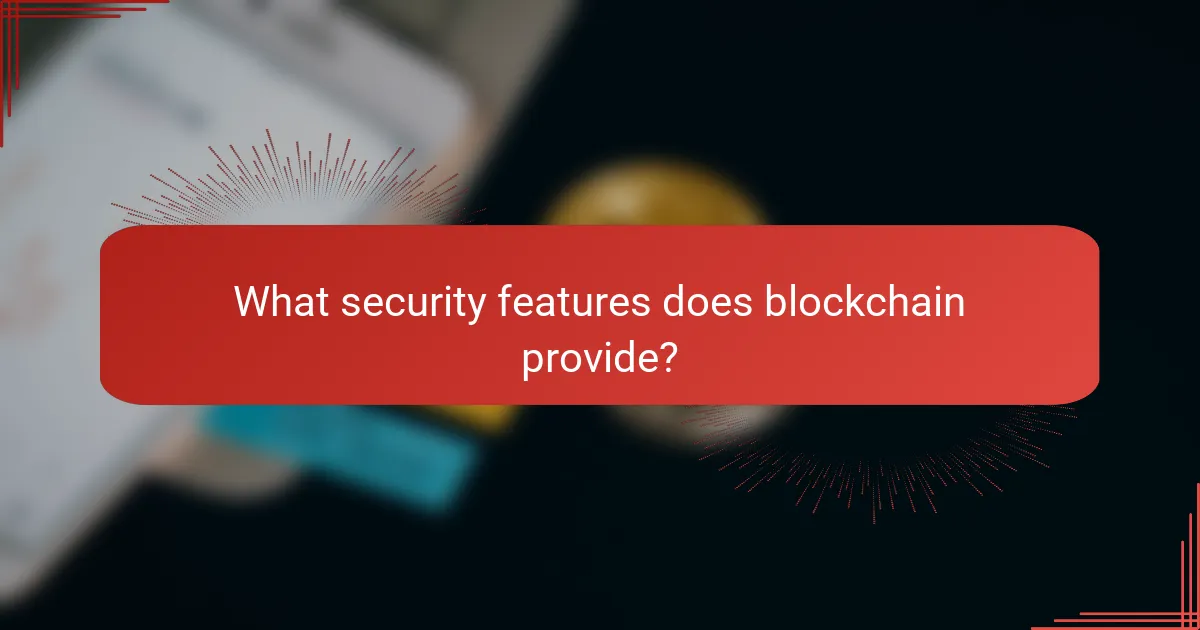
What security features does blockchain provide?
Blockchain technology offers robust security features that enhance data integrity, ensure consensus among participants, and facilitate secure transactions. Key aspects include cryptographic hashing, consensus mechanisms, and smart contract audits, all of which work together to protect the network from unauthorized access and fraud.
Cryptographic hashing for data integrity
Cryptographic hashing is a fundamental feature of blockchain that ensures data integrity by converting input data into a fixed-size string of characters, which is unique to that data. This process makes it nearly impossible to alter the original data without detection, as even a minor change will result in a completely different hash.
For example, if a transaction is recorded on the blockchain, its hash is generated and stored. If someone attempts to modify the transaction, the hash will change, alerting the network to potential tampering. This mechanism is crucial for maintaining trust in decentralized systems.
Consensus mechanisms like Proof of Work
Consensus mechanisms, such as Proof of Work (PoW), are essential for validating transactions and maintaining the security of the blockchain. In PoW, participants, known as miners, compete to solve complex mathematical problems, and the first to succeed gets to add a new block to the chain. This process requires significant computational power, making it costly and time-consuming to attempt fraud.
While PoW is effective, it can lead to high energy consumption and scalability issues. Alternatives like Proof of Stake (PoS) are emerging, which require less energy and can enhance transaction speeds, but each method has its own trade-offs regarding security and decentralization.
Smart contract audits for vulnerability detection
Smart contracts are self-executing contracts with the terms directly written into code. While they automate processes and reduce the need for intermediaries, they can also introduce vulnerabilities if not properly audited. Regular audits are crucial to identify and rectify potential security flaws before deployment.
Conducting thorough audits involves reviewing the code for common vulnerabilities, such as reentrancy attacks or overflow errors. Engaging third-party security firms for audits can provide an additional layer of assurance, ensuring that smart contracts function as intended without exposing users to risks.
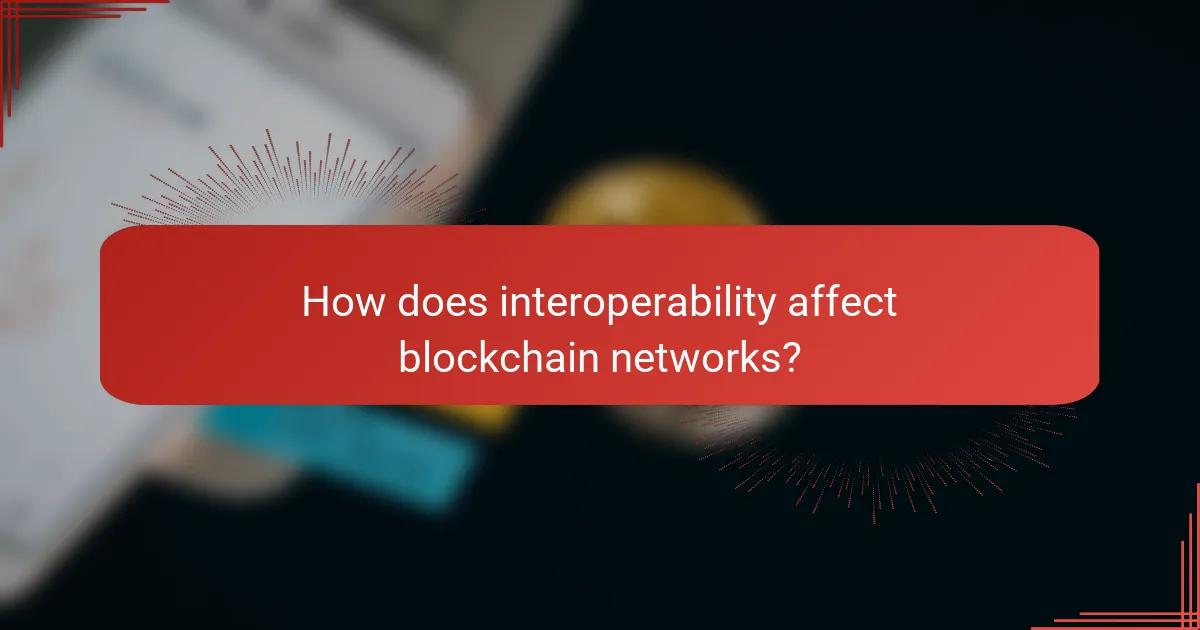
How does interoperability affect blockchain networks?
Interoperability significantly enhances blockchain networks by enabling them to communicate and share data seamlessly. This capability allows different blockchains to work together, improving efficiency and expanding the potential use cases for decentralized applications.
Cross-chain communication protocols
Cross-chain communication protocols facilitate interactions between distinct blockchain networks. These protocols allow for the transfer of assets and data across chains, which can enhance liquidity and broaden the functionality of decentralized applications. Examples include protocols like Cosmos and Chainlink, which aim to create a more interconnected blockchain ecosystem.
When implementing cross-chain solutions, consider the security implications and the complexity of integrating multiple systems. It’s crucial to ensure that the protocols used are robust and have been tested against vulnerabilities.
Interoperability solutions like Polkadot
Polkadot is a leading interoperability solution designed to connect various blockchains into a single network. It utilizes a unique architecture that allows different blockchains, known as parachains, to communicate and share information efficiently. This design not only enhances scalability but also enables specialized blockchains to focus on specific tasks while still being part of a larger ecosystem.
Using platforms like Polkadot can simplify the development process for projects looking to leverage multiple blockchains. However, developers should be aware of the governance model and potential limitations of the parachains to ensure they align with their project goals.
Atomic swaps for decentralized exchanges
Atomic swaps enable users to exchange cryptocurrencies directly between different blockchains without the need for intermediaries. This technology ensures that the trade either completes in full or not at all, providing a secure method for cross-chain transactions. Atomic swaps can be particularly useful in decentralized exchanges (DEXs), allowing for greater flexibility and reducing reliance on centralized platforms.
When considering atomic swaps, ensure that both cryptocurrencies involved support the necessary protocols. Familiarity with the technical requirements and potential transaction fees is essential to avoid pitfalls during the exchange process.
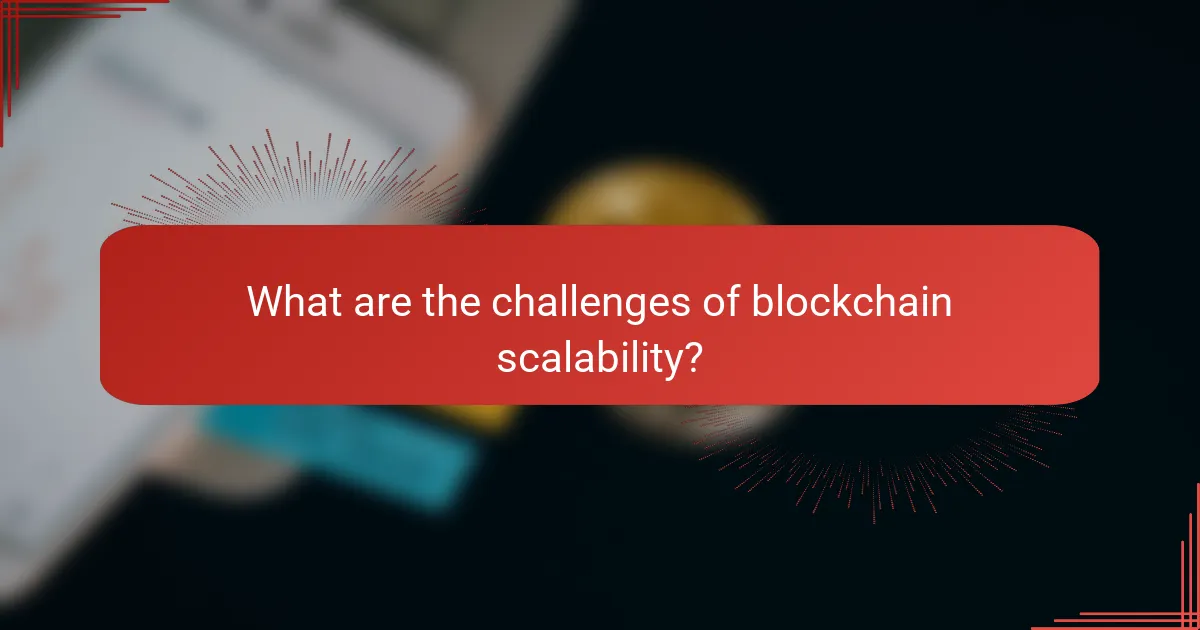
What are the challenges of blockchain scalability?
Blockchain scalability faces significant challenges, primarily due to limitations in transaction processing speed and network capacity. These issues can lead to delays and increased costs, particularly during periods of high demand.
Network congestion during peak usage
Network congestion occurs when the number of transactions exceeds the blockchain’s processing capacity. This results in slower transaction confirmations and can create a backlog, causing users to wait longer for their transactions to be completed.
During peak usage times, such as during major events or market surges, the network can become overwhelmed. Users may experience delays ranging from several minutes to hours, depending on the network’s current load and the fees they are willing to pay to prioritize their transactions.
High transaction fees in Ethereum
Ethereum users often face high transaction fees, especially during times of increased activity. These fees, known as gas fees, can fluctuate significantly based on network congestion and demand for processing power.
At peak times, gas fees can rise to tens or even hundreds of dollars, making small transactions economically unfeasible. Users should monitor gas prices and consider timing their transactions for off-peak hours to minimize costs.
Limited throughput in Bitcoin
Bitcoin’s scalability is constrained by its limited throughput, which is capped at around 7 transactions per second. This limitation can lead to delays and higher fees when the network is busy.
To manage these challenges, users can opt for solutions like the Lightning Network, which allows for faster and cheaper transactions off the main blockchain. However, these solutions require additional understanding and setup, which may not be suitable for all users.
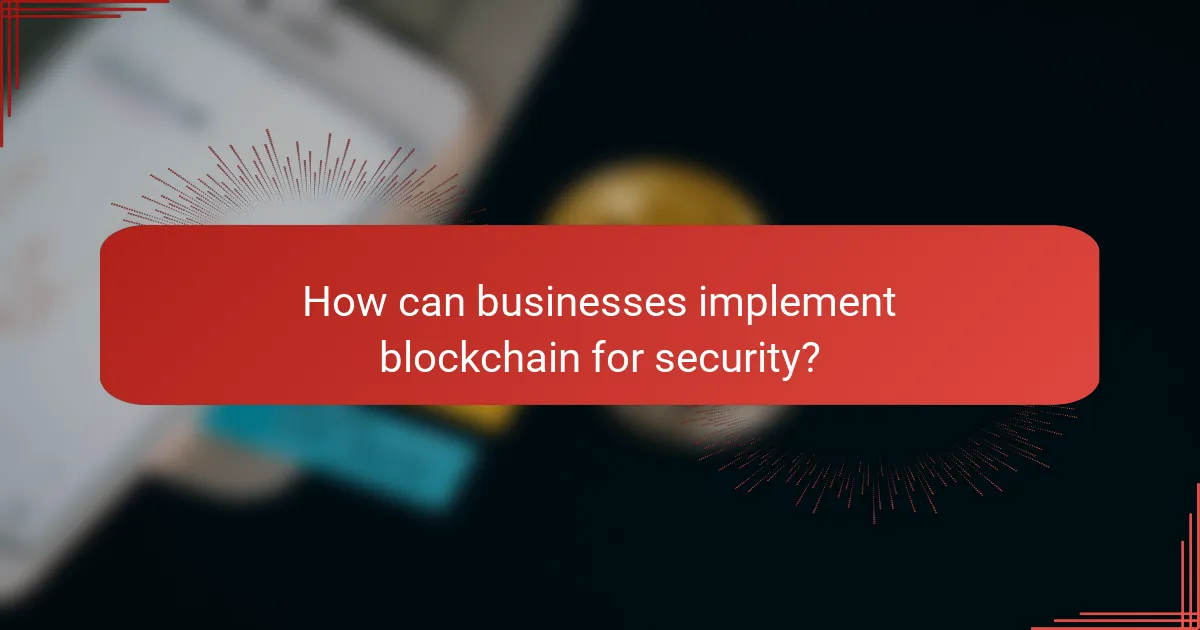
How can businesses implement blockchain for security?
Businesses can implement blockchain technology to enhance security by utilizing its decentralized nature, which reduces the risk of data tampering and unauthorized access. Key strategies include adopting private blockchain solutions, implementing decentralized identity management systems, and employing robust data encryption techniques.
Private blockchain solutions like Hyperledger
Private blockchain solutions, such as Hyperledger, allow businesses to create permissioned networks where only authorized participants can access and validate transactions. This controlled environment enhances security by limiting exposure to potential threats while still benefiting from blockchain’s transparency and immutability.
When considering Hyperledger, businesses should evaluate their specific use cases, as it is particularly suited for industries requiring stringent compliance and privacy, such as finance and healthcare. Implementing a private blockchain can streamline processes and reduce costs associated with data breaches.
Decentralized identity management systems
Decentralized identity management systems leverage blockchain to give users control over their personal information, reducing the risk of identity theft. By allowing individuals to manage their credentials without relying on a central authority, businesses can enhance security and build trust with their customers.
Organizations should consider integrating decentralized identity solutions to streamline onboarding processes and improve user verification. This approach not only enhances security but also complies with regulations like GDPR, which emphasizes user data protection.
Data encryption techniques for sensitive information
Data encryption is a critical component of blockchain security, ensuring that sensitive information remains confidential and protected from unauthorized access. Businesses should implement strong encryption algorithms to safeguard data both at rest and in transit.
Common encryption techniques include symmetric and asymmetric encryption, with the choice depending on the specific security needs and infrastructure. Regularly updating encryption methods and conducting security audits can help mitigate risks associated with data breaches.
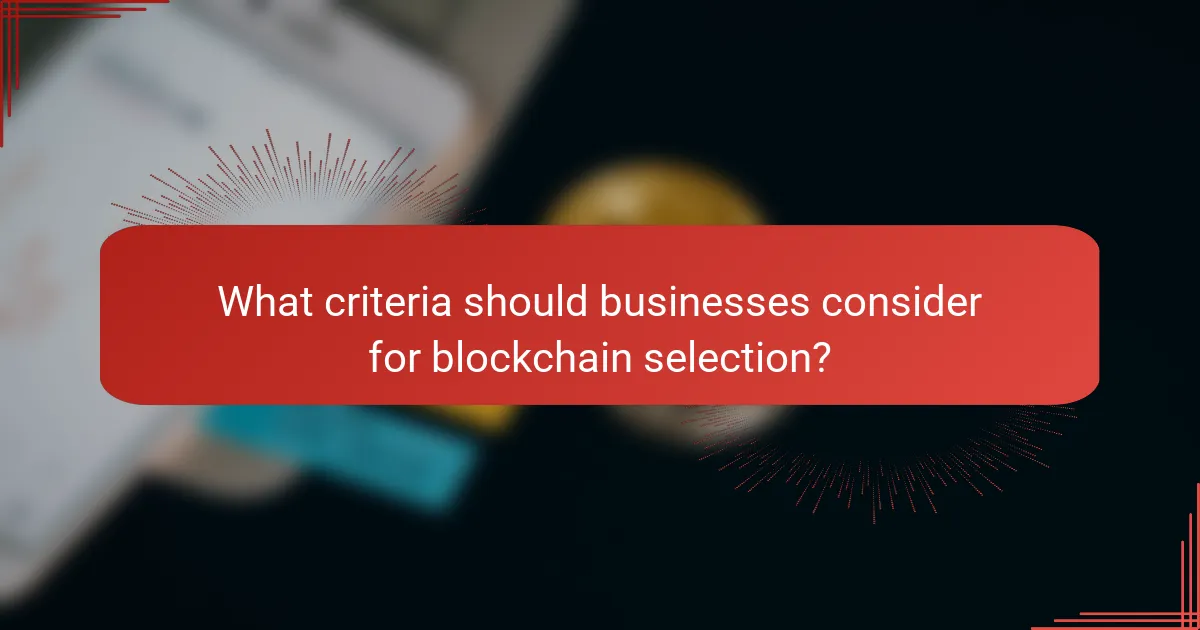
What criteria should businesses consider for blockchain selection?
Businesses should evaluate scalability, security, and interoperability when selecting a blockchain solution. These criteria ensure that the chosen technology can meet current and future demands while safeguarding data and enabling seamless integration with other systems.
Scalability requirements based on use case
Scalability is crucial for businesses that anticipate growth or fluctuating transaction volumes. Depending on the use case, a blockchain should handle increasing loads without significant delays or costs. For instance, a supply chain application may require a blockchain capable of processing thousands of transactions per second, while a smaller project might only need a few dozen.
When assessing scalability, consider factors like transaction speed, network capacity, and the consensus mechanism. Blockchains using Proof of Stake or Layer 2 solutions often offer better scalability compared to traditional Proof of Work systems. It’s essential to choose a solution that aligns with your expected transaction volume and user growth.
Security protocols and compliance standards
Security is paramount in blockchain technology, as vulnerabilities can lead to significant financial and reputational damage. Businesses should look for blockchains that implement robust security protocols, such as encryption, multi-signature wallets, and regular audits. Compliance with industry standards, such as GDPR for data protection in Europe or HIPAA for healthcare data in the U.S., is also vital.
Evaluate the blockchain’s ability to meet regulatory requirements relevant to your industry. For example, financial services must adhere to strict anti-money laundering (AML) and know your customer (KYC) regulations. A blockchain that provides built-in compliance features can save time and resources while ensuring adherence to legal obligations.
